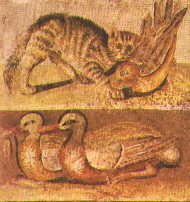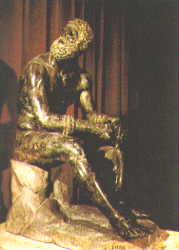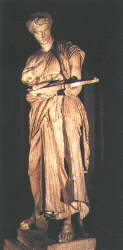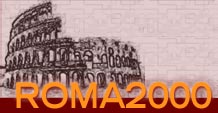National Museum of Rome

Baths of Diocletian
Octagonal Hall
Palazzo Massimo
Palazzo Altemps
Mosaic of cat attacking
a turkey
The National Museum of Rome, which possesses one of the world's most important archaeological collections, is housed in three different facilities: the Baths of Diocletian, which include the Octagonal Hall, the Palazzo Massimo, and the Palazzo Altemps.The complex restructuring and renovation effort is partially completed, but work is still under way. For this reason, only a portion of the Museum's exhibitions can currently be visited.
The historic headquarters of the Museum is the Baths complex built by Diocletian between the last years of the third century A.D. (the dedicatory inscription dated 306 A.D. is conserved in a fragmentary state in the Museum).
The building of the Baths, the largest in the ancient world, included many rooms besides the traditional calidarium, tepidarium and frigidarium-which were designed to hold 3,000 people at the same time. Ther was a natatio or frigidarium for swimmers (large open air swimming pool) and various other rooms, meeting rooms, libraries, nympheums, dressing rooms, concert rooms and rooms for physical exercises etc.
Baths of Diocletian
Following the transfer of the materials to the Palazzo Massimo, massive restoration work was begun on the Baths complex (at present the rooms are open to the public on a partial, irregular basis).
Rooms I-IX: exhibition of funerary materials (sarcophagi, etc.) and of artifact from the Baths themselves, or from other major public buildings, such as the decorations on the Temple of Aurelian.
Rooms X-XII: temporary exhibits.
The so-called "Masterpiece Roooms" have been set aside for the Epigraphical Department, which consists of almost 10,000 inscriptions. Plans also call for the first floor of the "Michelangelo" cloister to house a section on the protohistory of the City of Rome.
Address: V.le E. De Nicola, 79
Octagonal Hall
The Octagonal Hall stands at the southwest corner of the central complex of the Baths of Diocletian, in which it may have served as a passage area.
The most important of the works on exhibit are the Lyceum Apollo and the Aphrodite of Cyrene. The first, and IInd century A.D. copy of the original by Praxiteles, was found near the Baths of Trajan, by the Church of St. Peter in Chains, while the Aphrodite comes from Cyrene, in Libya, and represents a splendid copy from the middle of the IInd cent. A.D. of a late-Hellenistic original. All of the sculptures on display come from bath complexes, including the Anadyomene Aphrodite, the Heracles, the Lance-Bearer and the Cnidian Aphrodite.
Address: Via Romita
Palazzo Massimo
 Formerly the site of the preparatory school "Massimiliano Massimo", the building was constructed in 1883-87 by Camillo Pistrucci in imitation of the noble residences of the early Roman baroque period.
Formerly the site of the preparatory school "Massimiliano Massimo", the building was constructed in 1883-87 by Camillo Pistrucci in imitation of the noble residences of the early Roman baroque period.
Exhibited in the central hall are works that illustrate the political and ideological program of Augustus, including the statue of Augustus dressed as the Pontifex Maximus from the Via Labicana and the pictorial frieze of the noble sepulchre from the Esquiline hill.
Boxer at Rest
 The first floor offers iconographic works from the Age of the Flavians to the late Empire, with examples of the decorations used on imperial villas and aristocratic residences.In the section featuring the physical activities related to gymnasiums and public baths, visitors can admire two copies of the Discus Thrower by Myron.
The first floor offers iconographic works from the Age of the Flavians to the late Empire, with examples of the decorations used on imperial villas and aristocratic residences.In the section featuring the physical activities related to gymnasiums and public baths, visitors can admire two copies of the Discus Thrower by Myron.
The following section holds important sarcophagi, including an oval-shaped work from Acilia.
The second floor offers in-depth documentation on mosaic and pictorial decorations from the Ist cent. B.C. to the late Imperial Age.
On the basement level, a rich coin collection is displayed, including extremely rare pieces, such as the medaillon of Theodoric, the silver piasters of the Pontifical State with views of Rome snd the four ducats of Pope Paul II. The exhibition is completed by a section on luxury in the Roman world, featuring a rich selection of jems and jewels.
Young
girl from Anzio
Address: Piazza dei Cinquecento, 68
Palazzo Altemps
The Palazzo was commissioned by Girolamo Riario (1443-1488). In 1568 it passed into the hands of the Altemps family, which had it enlarged and built the courtyard. This feature of the building, without a doubt its most handsome, is credited to Martino Longhi the elder.
Restoration work has been under way since 1984, and steps are being taken to arrange the exhibit.
Apart from the Ludovisi Throne, which is kept in the Palazzo Massimo, the collection boasts works of great artistic value, such as the Gaul who kills himself together with his wife, a copy of an originalfrom Pergamon; the Ludovisi Ares, a copy traceable to Lysippus; the Castelporziano mosaic (IInd cent.), one of the most important known Roman mosaics; the Ludovisi Hermes, copy of a bronze original by the school of Myron; the Aphrodite of Cnidus, a copy of the reknowned Aphrodite by Praxiteles, and a colossal sarcophagus depicting a battle between Romans and Barbarians.
Address: Via di S.Apollinare

